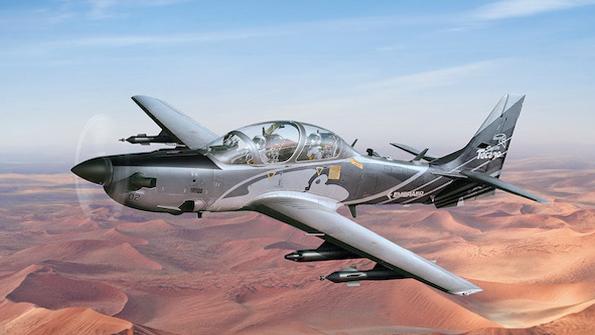Effective Close Air Support without compromising existing platforms

Aircraft have proven themselves in several different roles as fighters, bombers, and tactical reconnaissance platforms. And in much the same way as the ‘creeping barrage’ supported the successful advance of armies in the Great War, the aircraft has also had a decisive role to play in Air-Land Integration and the neutralization and destruction of enemy targets, sometimes in close proximity to friendly forces on the ground.
The ‘cab rank’ system employed by the Royal Air Force (RAF) using rocket-firing Typhoons and Tempests in the second world war during the break-out from Normandy and the advance into Germany brought the effectiveness of Close Air Support (CAS) into sharp focus. The ability to call upon help as easily as hailing a cab is a technique that has been proven and used to great effect in almost every conflict ever since, from Vietnam to the Gulf, and not just in major wars but also minor insurgencies around the globe.
The effectiveness of Close Air Support as a concept is not in question. The ability for airplanes such as the A-29 Super Tucano to attack targets on the ground with appropriate ordnance can have a devastating effect on the enemy. The ability also for an aircraft to have the agility to loiter in the combat area to meet a new and emerging threats as it unfolds is also essential, for a battlefield is often fluid and the threat seldom temporary or predictable.
The trend in recent years is towards an even greater need to defeat or neutralize an enemy on the ground and in cyberspace, and less so in the air. Despite this trend, air forces have arguably been slow to embrace aircraft specifically designed for a CAS role, preferring instead to use existing platforms that are not always appropriately equipped for the role they’ve been asked to fulfil. As President George Bush said 20 years ago, what’s the sense in sending US$ two million of missiles to destroy a US$ 10 tent that’s empty? And as the former Secretary of United States Air Force (USAF) Heather Wilson remarked more recently, ‘we should not be using an F-22 to destroy a narcotics factory in Afghanistan’.
But arguably the more important issue is cost-effectiveness. There is no virtue in deploying what is ostensibly an air superiority weapon like a jet fighter to conduct a CAS mission. Operational cost is undoubtedly a significant issue. In a six- to eight-minute taxi, a modern jet fighter burns the same amount, or even more, fuel than an A-29 consumes in an hour. Profligate use of high-cost assets to conduct operations for which they were not principally intended shortens their useful working life, removes them from their primary role, hastens the onset of replacement, and potentially hands an advantage to the enemy who has the patience to play the insurgency game long, until the western political and economic will to sustain contingency operations abroad begins to fail.
Military Doctrine focuses quite rightly on Mission Effectiveness; Joint Doctrine Publication 0-30 UK Air & Space Power demonstrates a clear understanding of the need for a balanced force: ‘In the contemporary operating environment, air power needs to be agile and adaptable…there is also a balance to be struck between investing in the right type, quality and quantity of equipment.’ A carefully balanced inventory of airpower assets and capabilities will be required for effective joint force employment across the full spectrum of conflict. Close Air Support exposes aircraft to different needs, challenges and threats which need to be designed for and accommodated.
Aircraft such as the A-29 Super Tucano, that are designed specifically for Air-Land integrated operations allow the appropriate weapon to be delivered upon the right target at the right time with proven precision and high lethality, from general purpose bombs and conventional rockets through to laser-guided weapons and precision guided munitions from 20,000ft; the same weapons, in fact, carried by the fast-jets.
The A-29 Super Tucano, produced by the Brazilian manufacturer Embraer, is highly maneuverable, especially at low level where the threat of ground defenses is at its greatest. With demonstrated survivability, including highly effective engine and cockpit armor, the aircraft has self-sealing fuel tanks and mission and platform system redundancy to operate within any given threat environment. The airframe itself is structurally superior, with a high level of safety integrity based on civil standards, and the canopy designed, tested and certified to resist bird strikes. Most importantly, the A-29 leaves only a very low IR and RCS signature, and is equipped with a broad range of defensive warning and decoy systems to prevent the aircraft from being ‘seen’ or targeted; again, often the same systems used on air superiority aircraft.
Proven in combat, the A-29 Super Tucano is already the platform of choice for 16 Air Forces worldwide, including the USAF, to deliver cost-effective Air-Land integrated support through attack, reconnaissance and advanced training capabilities, including the Air Forces of Afghanistan and Lebanon. A versatile and powerful turboprop aircraft known for its rugged and durable design, the A-29 has the additional advantage of being able to operate from unimproved runways and forward operating bases in austere environments and rugged terrain, further enhancing its operational flexibility. It is the only light attack aircraft in the world with a US Air Force Military Type Certificate.
Counter-insurgency operations in low-threat air environments will continue, and the need for dedicated integrated Air-Land platforms will only increase. Whether Air Forces will continue to use a Rolex to hammer a nail is a moot point, but the enlightened are already recognizing that low-cost platforms that are designed for a specific purpose can make a significant contribution to counter-insurgency operations without the fast-jet price tag.